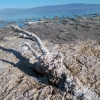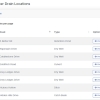
Why this matters
Every MS4 audit, whether it’s a quick screening or a multi-day deep dive, starts with one question: “Show me the records.” Communities that can put the right document on the table (or screen) in seconds walk away with clean reports and lower stress; those that scramble often leave with corrective-action letters or even fines. New York’s new MS4 General Permit (GP-0-24-001) underscores the point: stormwater management program (SWMP) records must be retained at least five years, and electronic storage is “recommended.” (dec.ny.gov)
Below is a tiered roadmap you can benchmark against your own program.
| Goal | “Have what the permit asks for and keep it in one place.” |
|---|---|
| What auditors expect to see | - Current SWMP plan- Most recent annual report- Inspection & maintenance logs (e.g., catch-basin cleaning, street sweeping)- Training sign-in sheets- Organizational chart showing stormwater roles (www3.epa.gov) |
| Typical system | A set of labeled binders or folders in a locked cabinet (paper or PDF on a shared drive). |
| Strengths | Meets minimum legal duty; inexpensive. |
| Weak spots | - Retrieval is slow, bad in a time-pressed audit.- No version control; backups are manual.- Limited searchability, so trends are hard to spot. |
| Goal | “Make every record easy to find, verify and back up.” |
|---|---|
| Upgrades | - All required documents scanned/OCR-indexed in a secure cloud or municipal server.- Uniform file-naming convention (e.g., 2025-04_CB-Inspection_District-2.pdf).- Photo documentation embedded in inspection forms.- Automated retention logic (flags when docs near 5-year expiry). |
| Tools we see municipalities using | - SharePoint, Google Workspace, or similar- Simple GIS viewer that links drainage assets to their inspection PDFs- Spreadsheet dashboards that tally inspections vs. schedule |
| Benefits | Faster audits (you can email a zip file on request); less risk of lost data; easier internal QA/QC. |
| Remaining gaps | Data is still siloed—asset data lives in GIS, work orders in a spreadsheet, photos in another folder. Cross-analysis requires manual effort. |
| Goal | “Documentation isn’t just stored; it drives day-to-day decision-making.” |
|---|---|
| Key features | - Asset-centric platform (e.g., Roadwurx for small departments, Cartegraph or Cityworks for large ones) where each pipe, basin, or outfall links to every inspection, work order, and photo.- Mobile data capture with GPS-stamped photos—no paper transcription.- Automated reminders for overdue tasks and annual report milestones.- Dashboards & KPIs (e.g., % of inlets inspected YTD) for leadership and public transparency.- Immutable audit trail—who changed what and when. |
| Why auditors love it | - Evidence is geolocated and time-stamped, proving work actually happened.- System can export a full “audit packet” in minutes.- Trend analytics demonstrate continuous improvement, not just compliance. |
| Bonus value | Data doubles as capital-planning intel (budget asks are backed by hard numbers). |
Under EPA guidance, each MS4 is typically reviewed once per five-year permit term, often near permit renewal. (withersravenel.com) A surprise inspection can still occur after spills, complaints, or enforcement actions—another reason to keep records evergreen.
Inventory today’s documents. Use the “Potential information to review” list in EPA’s MS4 Evaluation Guidance as a checklist. (www3.epa.gov)
Close baseline gaps. Make sure nothing on that list is missing or out-of-date.
Choose a digital home. If budgets are tight, start with a well-structured cloud folder; if you already use a CMMS or GIS, investigate its document-linking features.
Pilot mobile inspections. Even a free app that embeds GPS into photos is a leap from handwritten sheets.
Automate reminders. Outlook or Google calendar alerts beat relying on memory; full platforms add built-in task management.
Review annually—before auditors do. Tie the review to your April 1 SWMP update deadline (required in NY). (dec.ny.gov)
Good documentation meets the letter of the permit; Better cuts retrieval time and adds redundancy; Best turns records into real-time management tools.
Electronic storage and five-year retention are no longer “nice to have” but explicit permit language.
A tiered upgrade path lets smaller towns start simple and scale as resources allow.
NYSDEC General Permit GP-0-24-001 – Fact Sheet & Permit text.
EPA MS4 Program Evaluation Guidance – What auditors review and why.
WithersRavenel MS4 Permitting 101 – Quick explainer on audit timing. (dec.ny.gov, www3.epa.gov, withersravenel.com)
Document ready? Audit ready.
 Wetlands are often described as the kidneys of the watershed because they filter, slow, and transform the water that passes through them in ways that …
Wetlands are often described as the kidneys of the watershed because they filter, slow, and transform the water that passes through them in ways that …
 Field inspections of catch basins, manholes, culverts, and outfalls form the foundation of responsible stormwater management. These routine checks giv…
Field inspections of catch basins, manholes, culverts, and outfalls form the foundation of responsible stormwater management. These routine checks giv…
 Habitat disruption around drainage structures is often subtle at first, and many of the earliest signs tend to appear during ordinary field work rathe…
Habitat disruption around drainage structures is often subtle at first, and many of the earliest signs tend to appear during ordinary field work rathe…
 Harmful algal blooms have become one of the most pressing water quality problems in many regions, and their rise has been linked to a complicated blen…
Harmful algal blooms have become one of the most pressing water quality problems in many regions, and their rise has been linked to a complicated blen…
 The Salton Sea is one of California’s most unusual and tragic landscapes, a place shaped by accident, transformed by ambition, and ultimately pu…
The Salton Sea is one of California’s most unusual and tragic landscapes, a place shaped by accident, transformed by ambition, and ultimately pu…
 *The screenshots used in this article are from Roadwurx, an asset management software created for road maintenance departments. Managing a town’…
*The screenshots used in this article are from Roadwurx, an asset management software created for road maintenance departments. Managing a town’…